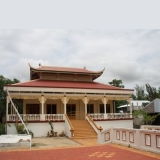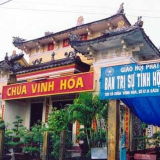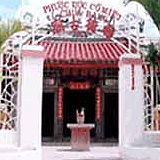Ba Ria-VT - Ba Ria - Con Dao - Vung Tau
Hue City - Phu Xuan - Thuan Hoa
Kien Giang - Ha Tien - Rach Gia - Phu Quoc
Thua Thien - Hue - Huong Thuy - Huong Tra
Tien Giang - My Tho - Go Cong
Vietnam » Bac Lieu
Place »

|
Quan Am Phat Dai Vietnam » Bac Lieu Place » Temple Đê Biển, Phường Nhà Mát, Bạc Liêu, Vietnam 346 views 💖 2 |
|
Quan Âm Phật Đài (Phat Ba Nam Hai), also known as the Quan Am Pagoda, is a Buddhist temple located in Bac Lieu, Vietnam. The pagoda is dedicated to Quan Am (also known as Guanyin or Avalokitesvara), who is a bodhisattva associated with compassion and mercy in Buddhist teachings. | |

|
Chua Xiem Can Vietnam » Bac Lieu Place » Temple Vĩnh Trach Đông, Bạc Liêu, Vietnam 346 views 💖 2 |
|
Xiem Can Temple (Chua Xiem Can) - The most beautiful and largest pagodain the region located in the Vinh Trach Dong commune of Bac Lieu province, Vietnam. It is a place of worship and a spiritual center for Buddhist practitioners in the local community. It was onstructed in 19th century with a very special architecture style. The temple is on the same road that leads to the Bac Lieu Bird Sanctuary. | |

|
Nha Cong Tu Bac Lieu Vietnam » Bac Lieu Place » Historical Place 13 Điện Biên Phủ, Phường 3, Bạc Liêu, Vietnam 321 views 💖 2 |
|
Nha Cong tu Bac Lieu, or the Bac Lieu Mansion, is a historic and iconic building located in Bac Lieu, Vietnam. It is known for its architectural beauty and cultural significance. The mansion was built during the early 20th century and belonged to the affluent Ho family, who were prominent landlords and businessmen in the region. | |

|
Bac Lieu Vietnam » Bac Lieu Place » City Vietnam 67 views 💖 1 |
|
Bac Lieu is a province located in the Mekong Delta region of southern Vietnam. It is situated on the southern coast of the country and borders the Gulf of Thailand. The province's capital city, also named Bac Lieu, is a vibrant and bustling city known for its rich cultural heritage, historical landmarks, and natural beauty. It had a population of 240,045 in 2016. | |

|
Chua Quan De Vietnam » Bac Lieu Place » Temple Vĩnh Trạch, Bạc Liêu 280 views 💖 2 |
|
Chùa Quan Đế, also known as Quan De Pagoda, is a Buddhist temple located in Vinh Trach commune, Bac Lieu province, Vietnam. It is a significant religious and cultural site in the region. Chua Quan De is dedicated to worshiping Quan De, a local deity revered in the region. Quan De is believed to be a deity associated with protection, fortune, and prosperity. | |

|
Tinh Xa Ngoc Lien Vietnam » Bac Lieu Place » Temple Phường 2, Bạc Liêu, Vietnam 303 views 💖 1 |
|
Tịnh xá Ngọc Liên is a Buddhist temple located in Bạc Liêu, a province in the Mekong Delta region of southern Vietnam. The temple serves as a place for worship, meditation, and community gatherings, and it plays an important role in the daily lives of the local Buddhist community. | |

|
Chua Vinh Phuoc An Vietnam » Bac Lieu Place » Temple 34/168, Cao Văn Lầu, Phường 2, Bạc Liêu, Vietnam 301 views 💖 1 |
|
Chùa Vĩnh Phước An is a Buddhist temple located in Bạc Liêu, a province in the Mekong Delta region of southern Vietnam. The temple is part of the vibrant Buddhist tradition that is deeply woven into the cultural fabric of the region, serving both as a place of worship and as a community center. | |

|
Chua Vinh Hoa Vietnam » Bac Lieu Place » Temple 17B Cách Mạng, Bạc Liêu, Vietnam 339 views 💖 2 |
|
Chùa Vĩnh Hòa is a Buddhist temple located in Bạc Liêu, a province in the Mekong Delta region of southern Vietnam. Bạc Liêu is known for its rich cultural diversity, including a significant population of ethnic Vietnamese, Khmer, and Chinese communities, all of whom contribute to the region's unique cultural and religious landscape. | |

|
Thap Co Vinh Hung Vietnam » Bac Lieu Place » Historical Place Vinh Hung A, Vinh Loi, Bac Lieu, Vietnam 333 views 💖 2 |
|
Vinh Hung Ancient Tower (Thap co Vinh Hung) was discovered in 1911 and at that time, it was listed as one of the historical sites in southern Vietnam. The tower is also known as Luc Hien or Bhah Dhat tower. The tower is 8.9 meter-high. | |

|
Nha Hat Cao Van Lau Vietnam » Bac Lieu Place » Club Quang truong hung vuong, Bac Lieu, Vietnam 532 views 💖 3 |
|
Theater Cao Van Lau (Nha Hat Cao Van Lau) is a well-known theater located in Bac Lieu, Vietnam. It is named after the renowned Vietnamese cai luong (a form of modern folk opera) artist, Cao Van Lau. The theater is dedicated to preserving and promoting the traditional art form of cai luong, which has deep cultural roots in Southern Vietnam. | |

|
Phuoc Duc Co Mieu Vietnam » Bac Lieu Place » Temple Điện Biên Phủ, Phường 3, Bạc Liêu, Vietnam 308 views 💖 3 |
|
Phước Đức Cổ Miếu or Teochew Chinese Assembly Hall of Bac Lieu, located in Bạc Liêu, Vietnam, is an ancient and significant religious site with a rich cultural history. This temple, also known as the Phước Đức Old Temple, is dedicated to the worship of the deity Ông Bổn (Bổn Đầu Công), who is revered in the Chinese-Vietnamese community. | |

|
Quang Truong Hung Vuong Vietnam » Bac Lieu Place » Tourism Hung Vuong, Phuong 1, Bac Lieu, Vietnam 354 views 💖 2 |
|
Hung Vuong Square (Quang truong Hung Vuong) is a popular public square and a significant landmark in the city. Hung Vuong Square is named after Hung Vuong, who is considered the first legendary king of the Vietnamese people. The square serves as agathering place for locals and visitors alike and is often avenue for cultural events, festivals, and celebrations in Bac Lieu. | |